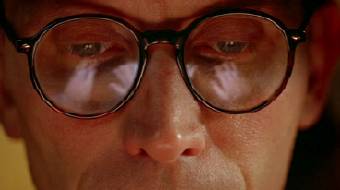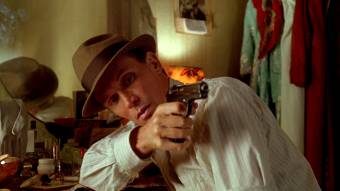|
David
Cronenberg's Naked Lunch was not the only
attempt made in translating Burroughs novel into a film.
There was a screenplay written much earlier by Brion Gysin
(and storyboarded by Balch) back in the 1960's. Along with Towers Open Fire and The Cut
Ups, there was much more film retrieved by P-Orridge,
and some of it included footage of what is presumed to be
scenes from this original screenplay. Although there was
interest in the project by the likes of Dennis Hopper, Mick
Jagger, David Bowie and the screenwriter Terry Southern,
funding never materialised and the idea slowly faded.

Gysin's
script differs in some ways from Cronenberg's and is more
an artist's vision of a film than a filmmaker's, yet it
has inevitably many similarities as they are both grounded
in the same novel. For example the central character is
William Lee (Burroughs' alter ego, Lee being his mother's
maiden name), and the Interzone still features but is changed
to Neverzone. Yet it is the differences that provide greater
insight, and one of the main differences to be observed
in the two scripts is the concept of reality. In Gysin's
version the narrative centres around the reality of the
novel. Hence when Lee escapes to Neverzone he is doing just
that and the reality is not questioned. Whereas in Cronenberg's
semi-biographical vision there is reason for the audience
to question the reality of Interzone as a fictional retreat,
even though it is dealt with as a part of the integeral
narrative construct. Sargeant writes:
"The
narcotic fragmentation suggested in the metanarrative
in and around the writing of Naked Lunch,
becomes mirrored in the films disregard for the division
between fantasy/reality, as William Lee (Peter Weller)
slides unannounced, between hallucination and consensus."
It
could be argued that the book has abstract parts of Burroughs'
own experiences within it so a straightforward handling
of it would translate biographical notions, and in part
this is true. But what Cronenberg has done is to work literal
biographical elements into the Naked Lunch narrative to reinforce those abstracted notions and to create
a questioning of reality. So the killing of Burroughs' wife,
Joan, is what sends Bill Lee into Interzone and not the
shooting of New York cops, as featured in the book and the
Gysin script. It is necessary to refer back to Burroughs
history to demonstrate the importance of this incident in
his life and thus the film. In A Report From The Bunker (Beckris, 1981) Burroughs states:
"I
am forced to the appalling conclusion that I would
never have become a writer but for Joan's death, and
to the realisation of the extent to which this event
has motivated and formulated my writing. I live with
the constant threat of possession, and a constant
need to escape from possession, from control. So the
death of Joan brought me in contact with the invader,
the ugly spirit, and manoeuvred me into a lifelong
struggle in which I have had no choice except to write
my way out."
So the Cronenberg film is very much in harmony with this
notion. As Cronenberg himself explained:
"It's
Joans death that first drives him to create his own
environment, his own Interzone." (p.211,
Snowden, 1992)
Which
is what the metaphor of the cops shooting in the original Naked Lunch is really about, Cronenberg is merely
making it explicit in his interpretation.
Cronenberg
uses the two writer friends Bill Lee has in the movie as
another bridge between fiction and reality. They are icons
representing the real figures of Burroughs' true friends
Allen Ginsberg and Jack Kerouac although they are not, in
same way as Bill Lee, direct representations of the men
in question.
The
questioning of reality is one concept of many that Burroughs
and Cronenberg had a shared interest in. One just has to
observe the central themes of Videodrome (1982) and Existenz (1999) to recognise
it as a significance within Cronenberg's work. Although
this is not the only area that Burroughs has influenced
Cronenberg in. He has frequently stated his main influences
have not been filmmakers but writers, Burroughs and Vladimir
Nabokov, because of "their status as 'alien' outsiders"
(p.211, Sargeant, 2001). One can see the former
of these literary influences clearly in the films mentioned
above, but in particular Videodrome. Its motifs concerned
with sexuality and his trademark body horror are converted
from Burroughs own ideas, in the "horror of female
genitalia" and expanded by "the aesthetics of
revulsion" (p.217, Snowden, 1992) as Cronenberg
puts it.

Another
common theme the two share is that of the insect motif.
The imagery of the insect is present in Cronenberg's 1986
film The Fly, in which the protagonist
suffers a metamorphosis into a fly, and can be found in
much of Burroughs literature, in particular The Soft
Machine, where the centipede features, sometimes in
a humanoid state. So it is not surprising to see this theme
present in the Naked Lunch movie. Cronenberg
lifts the abstract, literary iconography of the centipede
from the pages of Burroughs books and gives it a symbolic
meaning within the text of the film; a signifier of Interzone.
The representational context of insects does not stop with
the centipede. The typewriter Bill Lee uses to write himself
into Interzone (again a direct reference to the reality
of Burroughs writing himself out of 'possession' by Joan's
death), is represented as a drug induced hallucination of
a bug, connoting a life within the function of writing.
It is a controlling force too, as the bug typewriter in Naked Lunch serves as an Interzone 'agent'.
This has great referred meaning to Burroughs concepts as
it encompasses 'control' as well as the drug user/pusher
ideas of Junkie through to Naked Lunch in which, "Burroughs central analogy is the relationship
between addict and agent or pusher" (p12, Mottram,
1964).
Although
he has never been avant-garde in his film making to the
point that Burroughs was in the 1960's, Cronenberg also
shares a problematic categorization with Burroughs work,
as his themes fall somewhere between science fiction and
horror, two genres that Burroughs writing includes in various
guises.
The
only way in which Cronenberg strays from authenticity to
Burroughs influence is where the notion of sexuality appears.
Burroughs relationship with Kiki is implied in the film,
connoting the confronting of his homosexuality, yet a parallel
Joan-like woman is also created by Cronenberg within Interzone
and can be read as a devise to bring into question his sexuality,
thus making it commercially digestible. However I would
argue that the introduction of a woman resembling Joan is
multi-functional, as it serves as a constant iconic reminder
of Joan to show she is always on his mind, backing up what
has already been discussed regarding the omnipresence of
Joans spirit in Burroughs. It also provides a sexual tension
juxtaposed to Kiki, connoting the confusion still present
in his mind during this period of sexual adjustment.
Cronenberg
was responsible for putting Burroughs back into relevance
in the film sphere but with the emergence of Beat ten years later it was clear that the man and his work were
still important to the world of film. This is a largely
unknown independent work, directed by Gary Walkow, that
only enjoyed a limited theatrical release. It focuses solely
on the biographical events centred around the formative
years of Burroughs life, locating its narrative in the Carr/Kammerer
court case and Joans shooting. Although the film was not
a financial success and the historical accuracy of its narrative
is questionable, Beat demonstrates a continuing
influence in the mythology of Burroughs life as well as
the Beatnik community in general.
This
was followed by Darren Aronofsky's Requiem For A
Dream, based on the novel by Hubert Selby. Although
clearly not heavily influenced by Burroughs work it is a
contemporising of Beat generation concerns, showing that
they are as relevant in modern society as they were fifty
years ago. This is due to the inherent facets of the human
condition symptomised by so called civilized society, that
the Beat figures so astutely brought to
attention and that Requiem serves to highlight in part;
addiction, social (and political) opposition and unease
and a questioning of one's situation within this society.
Burroughs
knew all this and was the one to take it to the furthest
boundaries possible, challenging all media and creating
the strongest intelligible and coherent opposition to their
conventions there has been. So it is no wonder that the
reverberations of these achievements are still felt today.
Bibliography
Beckris, V. (1981) With William Burroughs - A Report from
the Bunker. 1st ed. New York: Grove Press.
Bridgett, R. An Appraisal of the Films of William Burroughs,
Brion Gysin and Antony Balch in Terms of Recent Avant Garde
Theory [online] Portland, Oregon: Gary Morris/Gregory Battle:
Available from: http://www.brightlightsfilm.com/39/cutups1.htm
Burroughs,W/Gysin, B/Chopin, H (1971) Electronic Revolution.
Cambridge, Massachusetts: Blackmoor Head Press.
Burroughs, W (2001) Naked Lunch. 1st ed. London: HarperCollins.
Burroughs, W/Gysin, B. (1978) The Third Mind 1st ed.
New York: Viking
Burroughs, W. (2001) The Soft Machine. 3rd ed. London:
HarperCollins
Cantrill, A & C, (1984) An Interview with Brion Gysin In: Sargeant, J. (2001) Naked Lens - Beat Cinema. 2nd
ed. Creation Books.
P-Orridge, G. (1997) "Thee Films": An Account
by Genesis P-Orridge. In: Sargeant, J. (2001) Naked
Lens - Beat Cinema. 2nd ed. Creation Books.
Hibbard, A. (1999) Conversations with William S. Burroughs.
1st ed. U.S.A: University Press of Mississippi
Miles, B. (1994) El Hombre Invisible: A Portrait. 2nd
ed. Hyperion.
Mottram, E. (1977) William Burroughs - The Algebra of Need.
1st ed. London: Marion Boyars.
Sargeant, J. (2001) Naked Lens - Beat Cinema. 2nd ed.
Creation Books.
Shero, Jeff (1968) William Burroughs Interview In:
Hibbard, A. (ed) Conversations with William S. Burroughs.
1st ed. U.S.A: University Press of Mississippi
Snowden, L. (1992) Which is the Fly and which is the Human? Cronenberg/Burroughs Interview In: Hibbard, A. (ed) Conversations
with William S. Burroughs. 1st ed. U.S.A: University Press
of Mississippi.
Studio International (1975) The Two Avant-Gardes. Nov/Dec
<< | introduction | part 1 | part 2 | part 3 | part 4
|